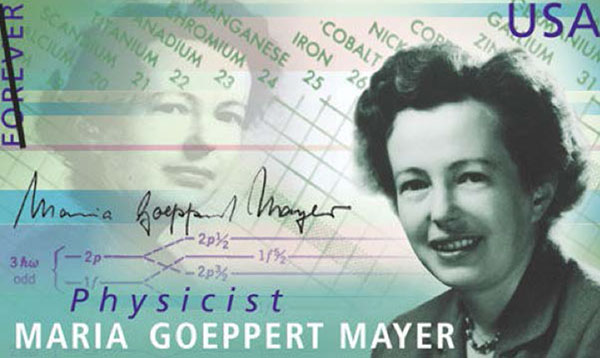Maria Goeppert Mayer: The 50th Anniversary of Her Nobel Prize
By Paul Halpern
 © United States Postal Service. All rights reserved.
© United States Postal Service. All rights reserved.
On April 13, 2013, at the APS April Meeting, an invited session was held to mark the 50th anniversary of Maria Goeppert Mayer’s Nobel Prize in Physics, an honor she shared with J. Hans D. Jensen and Eugene Wigner. (Half of the prize money in 1963 went to Wigner; the other half was divided between Jensen and Mayer.) Remarkably, Mayer was only the second women to receive the Nobel Prize in Physics. It had been a full 60 years since Marie Curie had been awarded the prize. The session was well-attended and stimulated considerable discussion.
The first speaker at the session was Prof. Steven Moszkowski of UCLA who spoke about “Maria Goeppert Mayer’s work on beta-decay and pairing, and its relevance today.” Moszkowski pointed out the importance of Mayer’s lesser known work in the theory of double beta-decay, in addition to her Nobel Prize winning work on the nuclear shell model and magic numbers. He showed how her theory of double beta-decay derived from her PhD work in double photon emission, along with her understanding of Fermi’s beta decay model. Moszkowski brought the discussion up-to-date by commenting on recent experiments looking for double beta decay without neutrino emission — a process that would violate lepton number conservation.
The second speaker was Prof. Karen E. Johnson of St. Lawrence University, who spoke about “Maria Goeppert Mayer and the Nobel Prize.” Johnson pointed out that while Marie Curie, the first woman to win the Nobel Prize in physics is well-known, Maria Goeppert Mayer, the second woman, who won the prize in 1963, is much lesser known. She speculated about reasons for this, including that the ceremony for Mayer took place shortly after Kennedy’s assassination, which dominated the news. She also pointed to a bias in news stories reporting the three winners that year. Johnson showed how Mayer’s father, and later her husband, American chemist Joseph Mayer, were very supportive of her work. Joseph Mayer respected and collaborated with her.
The third speaker was Prof. Elizabeth Baranger of the University of Pittsburgh, who spoke about “Remembrances of Maria Goeppert Mayer and the Nuclear Shell Model.” Baranger is the daughter of the late Nobel laureate in chemistry Harold Urey who knew the Mayers well. She spoke fondly about getting to know and being inspired by Maria Mayer when the Ureys and the Mayers lived in the same neighborhood in New Jersey, and then later when both families moved to Chicago. Baranger pointed out how because of “nepotism rules,” Maria Mayer was not appointed as a paid professor until later in life. For much of her seminal work, she was listed as “vol.” or a “volunteer.” Baranger also discussed Mayer’s early life in Göttingen, where, because of her father being a professor, she led a life of privilege. Mayer worked with Max Born, who had a great influence on her.
Following the third talk, there was a lively discussion about the “nepotism rule” that many universities cited when barring couples from taking paid positions at the same university. All in all, it was an enlightened session about a pivotal physicist.
The articles in this issue represent the views of their authors and are not necessarily those of the Forum or APS.
